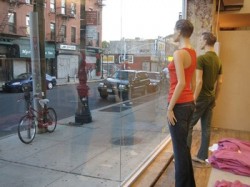 The media still doesn't know how to deal with plus-sized women. It examines them carefully, with a cocked head: Where do you fit in? How do we deal with you? Are you freaks? Are you acceptable?
The media still doesn't know how to deal with plus-sized women. It examines them carefully, with a cocked head: Where do you fit in? How do we deal with you? Are you freaks? Are you acceptable?With this exaggerated caution, which examines the plus-sized woman at arm's length as if she were part of a foreign, inscrutable culture, come some rather ridiculous assumptions. A recent New York Times article about the plus-size clothing industry spends several pages discussing how dressing plus-size women is "enormously complicated."
Really. Enormously complicated. Why? As the argument goes, since plus-size women weigh more, their weight is distributed more randomly and their body shapes are less predictable. Cutting patterns is thus a laborious process fraught with potential error -- what if one plus-size woman has more weight in her arms, another in her hips? As this piece and the peeved designers interviewed in it would have it, thin bodies all fit smoothly into the same basic physical prototype (and, I'd add, all conform to the same social norm), whereas plus-size bodies are freakish, wild, unmanageable deviations.
I'm going to share something with you, designers: I have an ass. It is, I would say, somewhat disproportionate to the size of my body. It is a classic bubble butt, and runs in my family. I am generally a size 2; half the pants I find don't accommodate the bubble. I'm also 5'4"; at least 90% of the pants I find in stores and online do not fit me at all. They are too wide in the waist and much, much too long. My friend, 5'3" and extremely petite with a tiny 25-inch waist and size 5 feet, has an enormous bust. She has to watch out buying clothing in her size because she often goes bursting out of it.
But I guess, when it comes down to it, thin women's bodies are the same. Hardly any variation, any distinctness; you could just cut a pattern for one of us and it'd fit us all. We're cookie-cutter.
With this clearly, not the case, these presumptions seem to come down to two things: sheer laziness and fat phobia/prejudice, and/or designers' fear of ruining their skinny-glamour with a plus-sized line. Lane Bryant was making 5 million dollars in 1923 and had narrowed the bodies of plus-size women into three categories -- flat-busted, full-busted, and evenly-sized all over. (Hmmm, reminds me that standard-size women have clothing in three categories as well -- tall, standard, and petite). They've managed to make clothing for larger women for nearly a century without, it would appear, enormous complications.
Plus-sized women can do so much better than the those of the fashion industry who, despite working in a creative profession, despite fashion's supposedly constantly changing adaptability to new trends and influences, despite millions of dollars spent sewing couture dresses for one walk down the runway, couldn't possibly deal with a size 16 body. Go elsewhere, plus-sized ladies, and demand the respect and intelligence you deserve.
Photo credit: Dyobmit
No comments:
Post a Comment